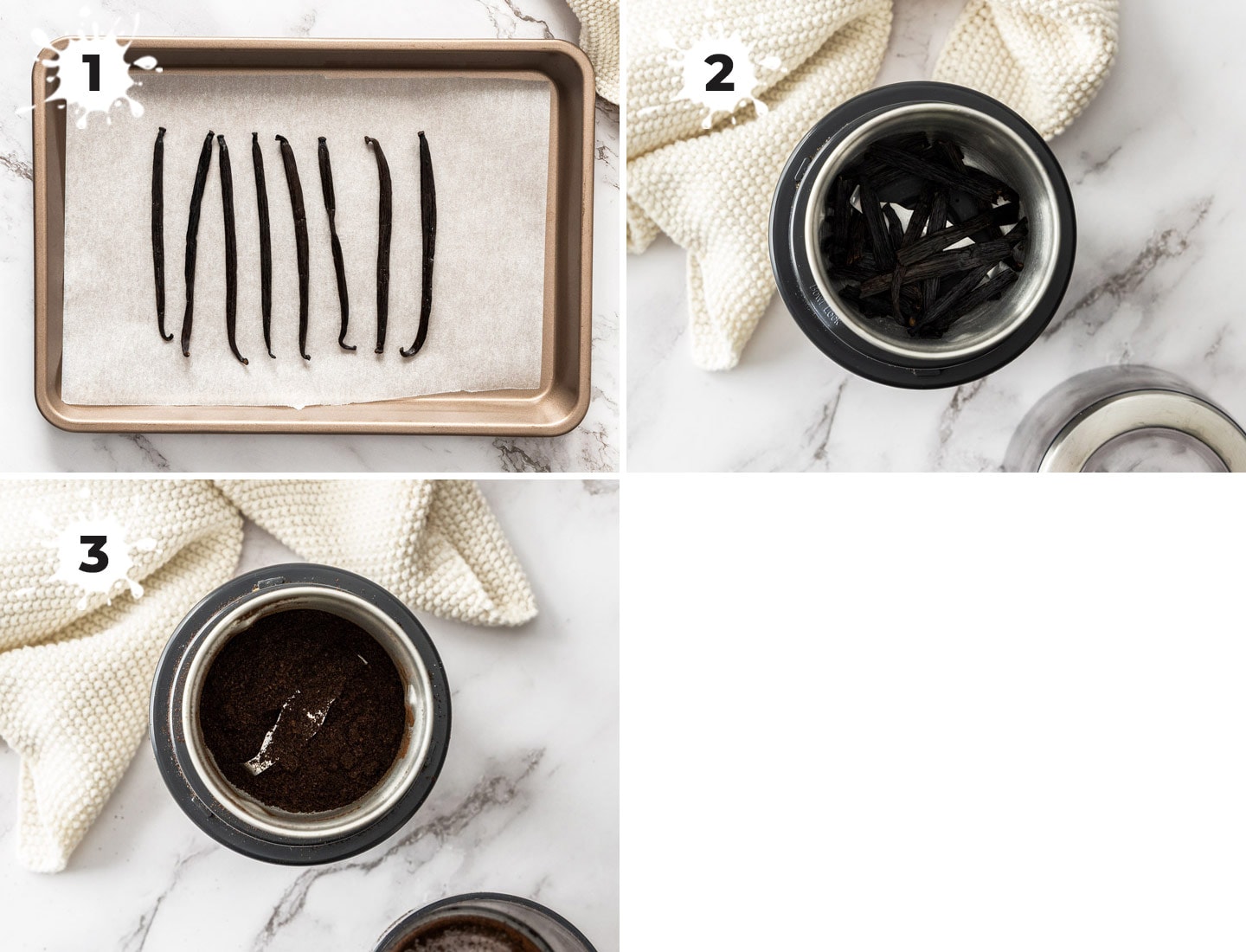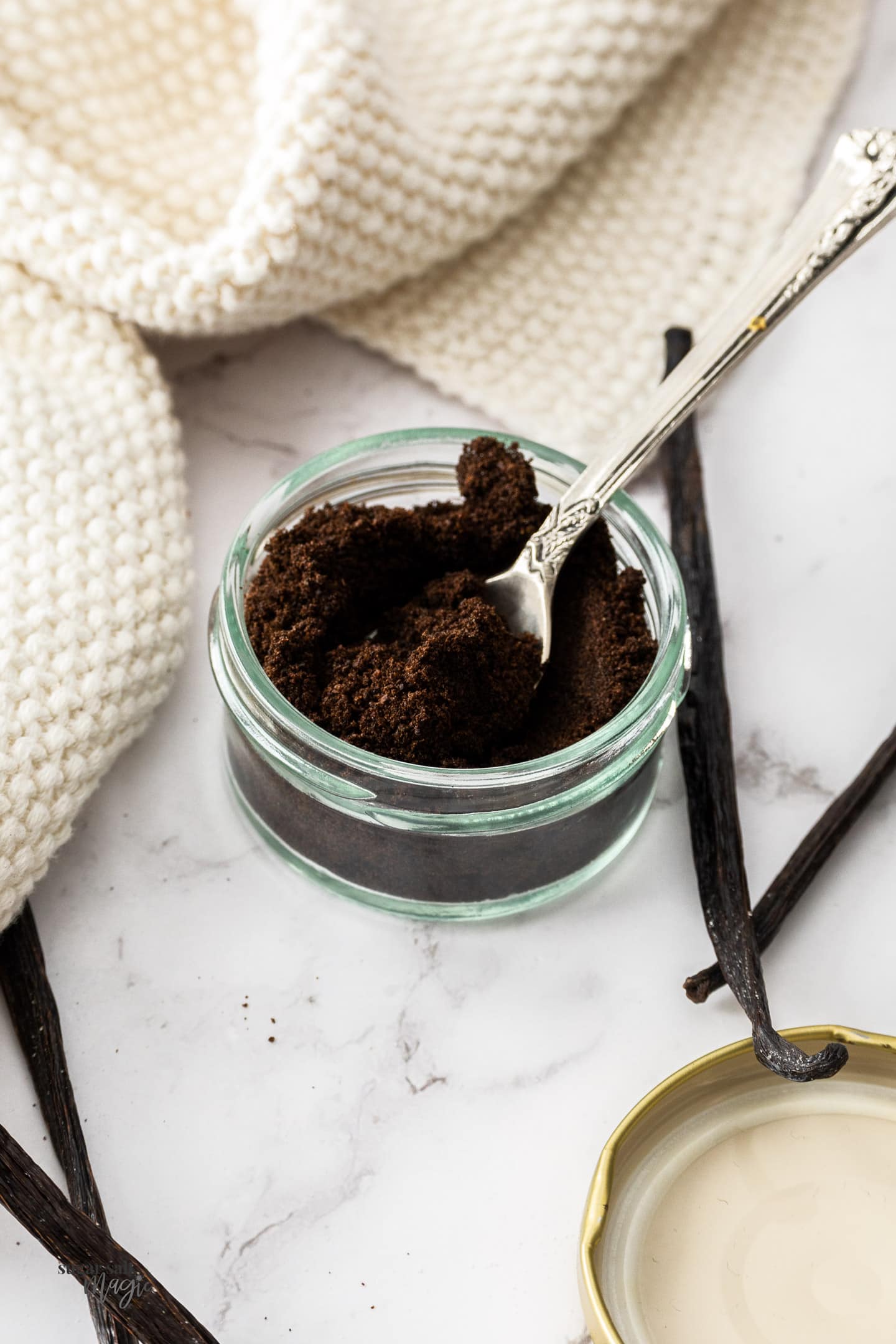If you want to use vanilla bean powder instead of vanilla extract, it has all the strong, fragrant flavor of vanilla with none of the waste. You can use it in all of your baked goods where vanilla extract would be used, but since it is pure vanilla, you can use less, which makes it cheaper.
When I make vanilla sugar, I love adding this pure vanilla powder. It makes the sugar smell great and I can use it in drinks, baked goods, and more.
Vanilla powder is a great way to amp up the flavour in these Vanilla bean cupcakes too.
As a devoted home cook and baking enthusiast, I’m always seeking ways to make restaurant-quality recipes at home. One ingredient that adds instant gourmet flair is vanilla bean powder. You’ve likely seen those beautiful little black specks in upscale ice cream, pastries, and more – that’s real vanilla bean powder. But with typical prices around $20 per ounce, this exclusive ingredient can be too expensive to justify buying.
Luckily, it’s surprisingly easy to make vanilla bean powder right in your own kitchen with minimal time and effort. Keep reading to learn all about vanilla powder and how to DIY it affordably using used vanilla beans.
What Exactly is Vanilla Bean Powder?
Vanilla bean powder is simply ground up dried vanilla beans It incorporates both the seed pods and seeds for maximal vanilla flavor and aroma
While most recipes only call for vanilla extract or seeds scraped from a fresh bean, powder makes use of the entire bean. This draws out all the flavor compounds – nothing goes to waste.
Vanilla powder has a rich, nuanced vanilla taste that blows vanilla extract out of the water. It provides intense vanilla flavor along with those signature specks you see in gourmet treats.
Since it’s alcohol-free vanilla powder is great for kids or anyone avoiding alcohol. It’s approximately twice as potent as extract so you only need half the amount in recipes.
Smart Ways to Source Vanilla Beans for Powder
High-quality beans are crucial for flavored powder. Check out these money-saving tips:
-
Buy grade B vanilla beans, which have slight cosmetic defects but perfect flavor for powder. Grade B beans cost around 25% less.
-
Purchase beans in bulk quantities. The price per ounce drops significantly at higher amounts.
-
Reuse beans from homemade vanilla extract. Get double duty from your beans by using them for extract first.
-
Buy beans from spice shops or ethnic markets rather than mainstream supermarkets. You’ll likely pay less per bean.
-
Consider lower-cost vanilla bean varietals like Mexican, Tahitian, or Indonesian beans.
With smart sourcing, you can get beans for $1-2 each to make powder very affordably.
Simple Process to Make Your Own Vanilla Powder
Thanks to the detailed instructions at My Frugal Home, I was able to DIY vanilla powder using supplies from my kitchen. Here’s an overview:
Dry out the beans fully to make them brittle. Use a low oven or air drying method.
Grind beans into powder via coffee grinder or high-powered blender.
Sift to remove any large pieces and achieve a super fine consistency.
Store powder in an airtight container away from light. Keeps over 2 years.
And that’s it! With just 4 simple steps, you can have fresh, gourmet vanilla powder from the comfort of home.
My Review of Homemade Vanilla Bean Powder
After some trial and error, I perfected my vanilla powder recipe. Here’s my feedback:
-
Intoxicating full vanilla aroma – fills your kitchen as it grinds
-
Gorgeous vanilla bean flecks visible in recipes
-
Ultra fine, smooth powder that incorporates perfectly
-
Boosts any recipe with complex vanilla richness
-
So affordable – $1 of beans makes 6+ teaspoons
-
Endless uses – I add it to everything from cookie dough to coffee
I’m never buying pricey pre-made vanilla powder again. My homemade version rivals any gourmet brand for a fraction of the cost.
Creative Ways to Use DIY Vanilla Bean Powder
Vanilla powder is endlessly versatile. Here are just some of the many ways to implement it:
-
Sprinkle on top of cappuccinos or coffee for visual appeal
-
Add to cookies, cake batter, pancakes, etc. for intense vanilla flavor
-
Mix into milkshakes, ice cream, pudding, and other desserts
-
Fold into buttercream frosting for both taste and vanilla specks
-
Blend into oatmeal, chia pudding, yogurt, and other breakfast foods
-
Stir into granola bars, energy balls, etc. for homemade flair
-
Use in place of vanilla extract at half the quantity (1/2 tsp powder = 1 tsp extract)
Let your imagination run wild! Homemade vanilla powder takes any recipe up a notch.
Frequently Asked Questions About Vanilla Bean Powder
If you’re new to vanilla powder, you likely have some questions. Here are answers to some of the most common FAQs:
Is vanilla powder the same as vanilla extract?
No, extract is made by soaking beans in alcohol. Powder is dried, ground whole beans. Powder has stronger vanilla taste.
Can you use vanilla powder in place of extract?
Yes, use half as much powder as extract called for in recipes (1/2 tsp powder = 1 tsp extract).
How long does homemade vanilla powder last?
Stored properly in an airtight container away from light, powder keeps its flavor for around 2-3 years.
What’s the best way to dry beans for powder?
Oven drying at 170°F for 1 hour or air drying beans for several days both work well. Make sure beans are fully dried out and brittle before grinding.
Can you use vanilla powder in beverages?
Absolutely! Add powder to coffee, milkshakes, protein shakes, hot chocolate, chai, and more for extra flavor.
Is vanilla powder gluten-free?
Yes, as long as no gluten-containing ingredients are used. Pure vanilla powder is naturally gluten-free.
Can you make powder from regular grocery store vanilla?
For best flavor, use beans marketed as “gourmet”. But any whole beans will work in powder.
So don’t let the price tag stop you from enjoying gourmet vanilla bean powder! With minimal effort, you can DIY it at home for a fraction of the cost using recycled vanilla beans. Get ready to seriously upgrade your baking, drinks and more with this aromatic vanilla powder.

How to make vanilla powder (step-by-step)
Ground vanilla is incredibly simple to make. Just one ingredient and essentially a two step process and you’re done. First, get the best beans you can find from a company that cares about the environment and its workers. You can get beans in bulk on Amazon, but you may also be able to find them at a bulk spice store near you.

Jump to the recipe for full ingredients and instructions.
- Place the vanilla bean pods on a baking sheet to dry. Put them in the oven at a low temperature (80C/170F) for about 90 minutes. You don’t need to watch them at this point; just put them in the oven to dry out.
- Grind the beans. For this quick job, get out your coffee or spice grinder. After five to ten minutes of cooling, the pods should be hard enough to break into pieces. Put those in the grinder and grind them up until they are very fine. I like to strain mine through a fine-mesh screen and then grind again to get rid of any bits that didn’t make it.

Where to use vanilla bean powder
When you heat food, the alcohol in vanilla extract will evaporate, taking some of the vanilla flavor with it. This will make the flavor less strong. Vanilla powder keeps the full flavor in baked goods like cookies and cakes, and it can also be used to heat up a custard base for ice cream. It’s great too added to recipes where you don’t want extra moisture like granola.
If you want to use vanilla in something other than sweets, you can. It tastes great in savory dishes too. In the same way that Greeks use cinnamon in pastitsio and other delicious savory dishes, vanilla can give any spice mix a nice twist, comfort, and balance. It’s great alongside warm spices like cinnamon, cardamom and cumin.
The little black vanilla flecks are not only flavorful but also visually striking. They add a touch of luxury and create anticipation for how something will taste. This is why vanilla powder is great for making vanilla cakes, cupcakes, panna cotta, and ice cream. As an added bonus, it looks great on buttercreams and icings, as well as on sugared donuts and the sugar coating on churros.
